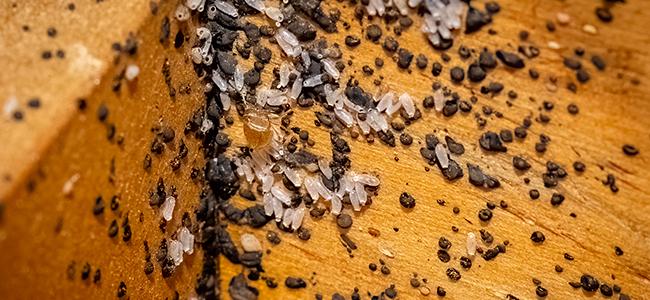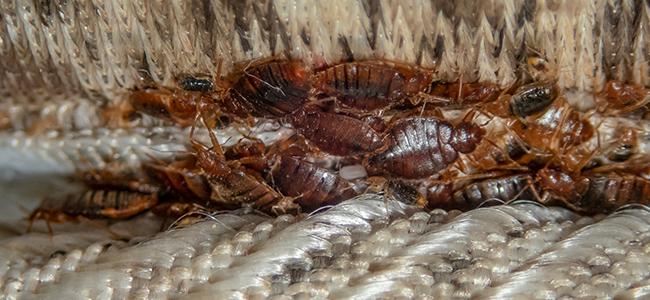
Fact vs. Myths: Bed Bugs In Washington D.C.
01/20/2022
Bed bugs are small parasitic pests that often resemble an apple seed to the naked eye. They have a wingless, oval-shaped body with a reddish-brown ...
READ MORE >

You wake up to the sound of your alarm, wishing you had another few hours to sleep. You've been home from your vacation for a few days, and it's now time to get back to real life. The vacation was wonderful, and it was great to come home too, but getting back into your normal routine after a break is always tough. You let the snooze alarm go off a couple of times before dragging yourself out of bed to get ready for work.
As you get ready, you absentmindedly scratch an itchy spot along your collarbone. A moment later, you do it again. Why are you so itchy? You pull the collar of your shirt down and look in the mirror to discover a series of red bumps on your skin that weren't there last night. Where did they come from? How did you get them? Were you bitten in the night while you slept?
Bug bites are often the first sign people discover when bed bugs invade their homes. Contrary to popular belief, bed bug infestations can occur in any house, no matter how messy or tidy, clean or dirty. Bed bugs are excellent at traveling and can climb into your bags or onto your clothing whenever you go out in public. Infestations frequently occur after a vacation when bugs in an infested hotel room crawl into your luggage and travel home with you.
However, it's not always easy to know for sure if you have bed bugs in your Washington D.C. home. Perhaps the bites you find on your body are from fleas or even mosquitoes. Maybe the bug you saw crawling into a crack in your floor was a tiny beetle or some other pest. If you're not sure whether bed bugs have gotten into your house, but you suspect they have, there are ways to determine if they have or not. The following information will help you make that determination.
If you find bugs in your house, especially if you find them in your bedroom or directly on your bed, your first reaction might be to panic. Many people have only heard horror stories about bed bugs, so the thought of experiencing an infestation yourself can be disturbing, to say the least.
However, after the initial shock of finding bugs in your bed, you need to ask yourself the question: Are these actually bed bugs? Bed bugs can be difficult to identify because they are similar in appearance to other bugs and can sometimes be misidentified. It is possible that you don't have a bed bug infestation at all but have other insects in your house. Some pests that are commonly mistaken for bed bugs include booklice, ticks, fleas, and spider beetles, to name just a few.
Regardless of what type of pests are in your house, it's important to have them properly identified so that you can take the appropriate steps to eliminate them. While some pests are easier to get rid of than bed bugs, any pest infestation must be dealt with if you want to live in a healthy, pest-free home. Pests can damage your home, spread diseases, or be an indication of other problems, such as moisture damage, so it's always important to have every pest problem evaluated.
Trying to identify the type of bugs you've found in your house on your own will probably be the first thing you try to do before you contact American Pest. Even if you get it wrong, it's helpful for your peace of mind, and when you want to explain your situation to our service technicians, to have a good idea about what type of pests you're dealing with. To do this, you need to know what bed bugs look like.
Bed bugs start as eggs, then go through five stages as nymphs before becoming full-fledged adults. Bed bug eggs are tiny, no bigger than a pinhead, white, and oblong. They can be laid singly or in clusters and are usually laid in hidden locations, such as in the crevices of a headboard or in cracks in the floor.
In about a week, bed bug eggs will hatch. First-stage nymphs are very tiny and a translucent white color, which makes them quite difficult to see. In order to develop from one stage to the next, the bed bugs must have a blood meal. Once they do, they can molt and move to the next nymph stage. Through each of the five nymph stages, the bed bugs will become progressively larger and darker in color.
By the time they become adults, bed bugs are a reddish-brown color with wide, flat, oval-shaped bodies. They are the approximate size and shape of a small, flat apple seed. Bed bugs have six legs and antennae that stick out the sides of their heads. After a meal, adult bed bugs swell and elongate. On average and under the right conditions, it takes a little over a month for a bed bug to go from egg to adult.
The female adults can lay around five eggs a day and will do so for as long as they have a food source. Bed bugs can live anywhere from six to twelve months and can go for weeks or months at a time without a meal.
Finding bed bugs themselves in your house is only one way to be alerted to a bed bug infestation. There are other signs that often accompany an infestation that can alert you to their presence, even if you haven't seen a single bed bug. These signs can be a good thing because bed bugs like to stay hidden, so finding other signs of their presence can help you identify an infestation before it grows into a huge problem.
Bed bug bites are often the first sign of an infestation that people notice. Bed bugs require blood meals to move from one stage of development to the next, so they will feast on your blood when given the opportunity. Because a sleeping human is an easy target, bed bugs are often in or around beds, which is how they got their name. However, they don't only infest bedrooms, and you may find them in any area of your house.
If you find bug bites on yourself or your family members that you don't recall getting from mosquitoes or other pests, you'll want to take a closer look to see if they could be from bed bugs. Bed bug bites are often confused with flea bites, but there are usually a few differences between the two.
Bed bugs and fleas both typically leave behind red itchy welts. However, fleas prefer the lower body extremities, especially around the ankle area or in creases, like where your elbows or knees are bent. In contrast, bed bugs prefer the upper body, especially around your neck and shoulders. The other key difference is that flea bites tend to occur in random, haphazard arrangements, while bed bug bites tend to show up in a more linear pattern.
Although bites are often the first sign of a bed bug infestation, they aren't the only sign. Another sign to look out for is blood spots. You'll often find these on your sheets, pillow, or blankets, but they can also appear in other areas, such as on your clothing or upholstered furniture. These spots of blood will be tiny dots on the fabric, but if you see them, especially if bug bites accompany them on your body, it's a positive sign of a bed bug infestation.
In addition to blood spots, you may also find tannish-brown streaks of left-behind bed bug fecal matter on your sheets, blankets, pillows, mattress, or other areas. These are also an indication of a bed bug infestation.
In the case of a large infestation, bed bugs sometimes start to give off a musty odor. If you smell something with an odor similar to when towels are left wet for too long and have started to mildew, it can be an indication of a severe bed bug infestation.
Once you see any of these signs, further investigation is warranted. Check in the gap between your mattress and headboard, along the seams of your mattress, on curtains, behind picture frames, and in cracks between floorboards. When you look in these areas, you want to inspect for live bed bugs, bed bug eggs, egg casings, and fecal matter. Finding any of these is a sign of a bed bug infestation.
If you've found any of the signs listed above, it's time to take action. Even if you're still not sure whether you have a bed bug infestation or not, it is always better to be safe than sorry. Having a professional pest technician with years of experience identifying your bed bug infestation will leave you with the peace of mind knowing one way or the other whether bed bugs are in your home.
If you find you do have an infestation, American Pest is ready to eliminate it for you. After our trained technicians complete their inspection, they'll go over our treatment process with you and provide you with paperwork that explains everything you need to do prior to our treatment.
We use thermal remediation to eliminate bed bug infestations, an advanced technology that is safe and environmentally responsible. Using no chemicals, we will heat your home to a temperature that is lethal to bed bugs, and we'll hold the temperature there for several hours until it can permeate walls and other areas where bed bugs may be hiding.
Thermal remediation is an ideal bed bug control treatment because it only takes one day to eliminate your bed bug infestation in its entirety. It eliminates adults, nymphs, and eggs and can reach areas that traditional treatments cannot. If you think bed bugs have invaded your house, you can trust American Pest to quickly, safely, and effectively take care of the problem for you. Contact us today to request your bed bug inspection and be on your way to a healthy, bed bug-free home.

01/20/2022
Bed bugs are small parasitic pests that often resemble an apple seed to the naked eye. They have a wingless, oval-shaped body with a reddish-brown ...
READ MORE >

12/03/2021
Bed bugs can be difficult to identify, but this guide is here to help you tell them apart from other pests in Washington D.C. Read on to get the ma...
READ MORE >

11/15/2021
Bed bugs may be small, but they can often cause major problems once they infest your Maryland home. Contact the professionals a...
READ MORE >

10/30/2021
Bed bugs can appear in almost any residential environment, from communal living to busy family homes. Contrary to popular belief, bed bugs do not c...
READ MORE >

Protect your home and family from nuisance and potentially damaging pests with a Preferred Care home pest control plan. Starting at $49/month

Don't let the bed bugs bite a second longer. Contact American Pest for the most comprehensive bed bug control in the industry. Learn More

Our certified rodent control pros will put an end to your frustration by getting rid of rats and mice inside your home. Learn More

Say goodbye to wood-destroying termites in your home when you contact American Pest for expert termite control. Learn More

Trust American Pest to deliver professional backyard tick control services that are guaranteed to get results. Learn More

Don't spend the warm-weather season indoors, find out how American Pest's professional treatments get rid of mosquitoes. Learn More
Fill out the form and recieve feedback in less than 5 minutes. For immediate service please call.